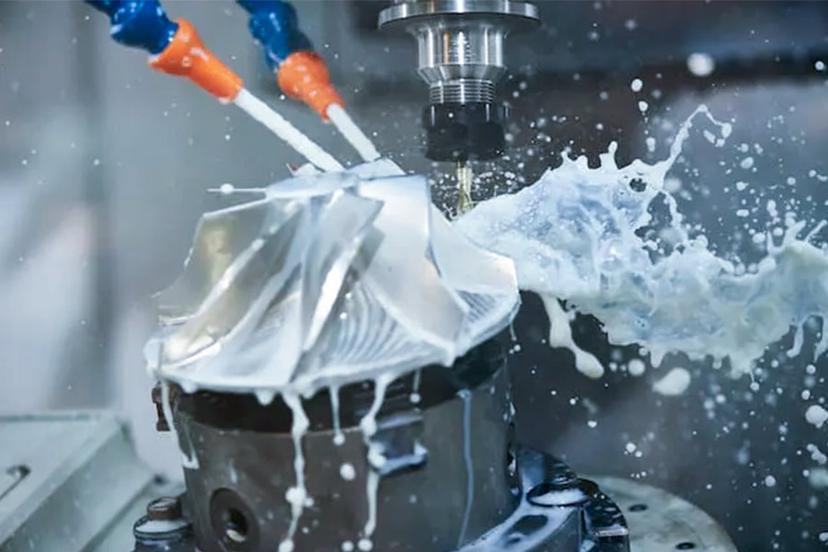CNC machining is an indispensable and important technologyin modern manufacturing. It uses computer control systems to accurately guide machine tools to perform various processing operations. This article will elaborate onhow CNC machining worksfrom the basic principles, workflow and key technologies of CNC machining.
What is CNC Machining?
CNC machining, in short, uses computer numerical control technology to precisely control machine tools to achieve automated processing of workpieces. The emergence of this technology has completely changed the shortcomings of traditional mechanical processing that relies on manual operations and cannot guarantee accuracy, making the processing process more standardized and precise. From complex three-dimensional parts to precision mold manufacturing,CNC-machiningmeets the needs of all walks of life for high-quality, high-efficiency machining with its excellent performance.


How Do CNC Machining Work Step by Step?
Here's how it works:
Step 1: Create a CAD drawing
The first step in the CNC machining technology process is to sketch the concept of the machined part on paper. However, we use precision machining CAD software designed for two-dimensional (2D) and three-dimensional (3D) modeling. The CAD drawing should be a to-scale model that provides information on inherent parameters such as thickness, depth, and other dimensions.
Step 2: Convert from CAD to CAM model
Convert CAD models to CNC code (G-code) using CAM (Computer Aided Manufacturing) software. This code instructs the machine how to move and cut.
Step 3: CNC machine configuration
In this step, the CNC machinist sets up the precision machine to execute the programmed G-code and M-code. It involves preliminary checking of machining input parameters and fixing the workpiece on theCNC machine.
Step 4: CNC machinist executes program
Nowadays,cnc machine workingmainly by entering a codeto start manufacturing and moving accordingly. Remember, CNC machining technology is automated and won’t stop until the machinist presses the stop button. Therefore, the operator must remain vigilant during observation in case of sudden errors, emergencies, or situations requiring adjustments.


What are the types of CNC machining?
1.Grinding Machining
Grinding machiningis a processing method that uses abrasive tools (such as grinding wheels, whetstones, etc.) to grind the surface of the workpiece. The basic principle is to remove material on the surface of the workpiece through friction, scoring and scraping between the grinding tool and the surface of the workpiece to achieve the required size, shape and surface quality.
Grinding machining is widely used in machinery manufacturing, especially where high precision and high surface quality are required. It can process internal and external cylindrical surfaces, conical surfaces and flat surfaces of various workpieces, as well as special and complex forming surfaces such as threads, gears and splines. In addition, grinding can also process materials that are difficult to process with other machine tools, such as hardened steel, carbide, glass, ceramics, etc.
2.Lathe Machining
The basic principle of lathe machining is to use lathe equipment to remove excess material from the workpiece by rotating the workpiece and making it move relative to a fixed or moving cutting tool (such as a turning tool) to obtain the required shape, size and surface quality. parts or workpieces. Lathe machining can complete a variety of processing tasks, including but not limited to outer circle processing, inner circle processing (such as boring), end face processing, grooving, cutting off, forming surface processing, etc.
3.Milling Machining
Milling is the process of cutting material from a workpiece using a rotating tool to create the desired shape and size. The selection of cutting tools and the setting of processing parameters have a significant impact on the processing effect. Generally speaking, high-speed steel tools are suitable for milling most metallic materials, while carbide tools are suitable for harder materials. In addition, the settings of parameters such as cutting speed, feed amount and cutting depth also need to be reasonably selected based on specific materials and processing requirements.
Milling Machiningis suitable for workpieces of various materialsand shapes, including flat surfaces, grooves, spiral surfaces, tooth surfaces, formed surfaces and outer circles, etc. In mass production, in addition to processing long and narrow planes,mill machiningcan almost replace planing and become a common method for processing planes, grooves and formed surfaces.


What is the Principle of CNC Machining?
The Principle of CNC Machiningis to control and operate the movement of the machine toolthrough a computer control system to achieve precise processing of the workpiece. First, CAD (computer-aided design) software is used on the computer to mathematically describe and geometrically model the workpiece to generate a geometric model of the workpiece. In this step, mathematical expressions such as curves and surface equations are used to describe the shape and dimensions of the workpiece. Then, the designed model is converted into G code that can be recognized by the machine tool. The G code describes in detail the tool's movement trajectory, processing speed, tool selection and other information during the processing process.
What are the advantages of CNC machining?
Capabilities:CNC machining can produce a wide variety of parts, shapes, features and highly complex geometries. The technology allows manufacturers to create both self-contained end-use parts and fully functional assemblies, providing tremendous design freedom and flexibility. In addition, it can manufacture large and micro parts.
Accuracy and Precision:As long as the CNC design is optimized,CNC machiningcan replicate the design with extremely high accuracy. CNC machines are highly precise and can produce parts with extremely tight tolerances. Most aspects of the CNC process are computer controlled, minimizing errors and ensuring consistency.
Speed:CNC machining can deliver complex geometries quickly. This feature is especially beneficial for prototyping applications. CNC machining reduces turnaround time from design to finished product compared to traditional manufacturing methods that involve numerous time-consuming processes.
Versatility and scalability:CNC machining is versatile, suitable for both one-off prototypes and medium-volume production. This technology enables the consistent production of multiple units of consistent quality. The range of processes and technologies within CNC machining means there is a suitable method for almost any application requirement.
Material Compatibility:CNC machining is compatible with a variety of materials, including metal, glass, plastic, stone, and wood. If the material can be sourced in chunks, it is likely suitable for CNC machining. This compatibility is not limited to standard engineering materials, but also includes more specialized options, providing flexibility for a variety of industrial applications.
What are the disadvantages of CNC machining?
High setup costs:The initial setup costs for CNC machining can be quite high. CNC machines are relatively expensive, and the cost of advanced industrial models makes them suitable only for large-scale industrial production.
High-volume production speed: CNC machining can produce individual parts relatively quickly. However, batch production can be very time-consuming since most CNC machines can typically only produce one unit at a time.
Cost of complex geometries:The complexity of a part is directly proportional to its machining time, effort and cost. Producing complex designs can significantly increase production expenses due to the need for extended operation times and the use of more advanced CNC machines.
Material waste:CNC machining is a subtractive manufacturing process that generates large amounts of waste. The process involves sculpting materials to create finished parts, which generates a lot of waste compared to additive and molding technologies.
Design Limitations:Despite CNC machining capabilities, there are inherent design limitations. Certain features and geometries, such as curved holes, extremely thin walls, and straight interior edges, cannot be machined efficiently. These limitations require design adjustments and optimizations that may sometimes compromise the original design intent.
What are the factors that affect CNC machining costs?
| Factor | illustration |
| Material cost | The prices of different materials vary greatly, such as aluminum, steel, stainless steel, brass, plastic, titanium alloy, etc. Each material has its specific cost and use. |
| Equipment cost | High-end machine tools typically have greater accuracy, greater efficiency, and more features, but they also cost more. Regular equipment maintenance and depreciation expenses also need to be included in the processing cost. |
| Labor costs | Experienced technicians can write programs and operate machine tools more efficiently, reducing errors and downtime. |
| Tool and fixture costs | Specific tools may require customization or special handling, and tool wear and replacement can also increase costs. The fixture is used to fix the workpiece to ensure machining accuracy, and its design and manufacturing also require costs. |
| Post-processing costs | Post-processing steps such as heat treatment, surface treatment, cleaning and inspection can addCNC machine price. |
| Logistics and transportation costs | For large or heavy parts, logistics and transportation costs are also a part that cannot be ignored. |
| Energy and auxiliary material costs | The electricity, coolant, lubricants, etc. consumed during CNC machining also need to be included in the cost. |
| Management and administrative costs | including management and administrative expenses related to project management, quality control, equipment maintenance records, etc. |
Choose LS to provide you with one-stop service
Obtaining high-quality machining services remains an essential goal for rapid production success. At LS, we, as amachining mill, offer a full range of machining services to meet your machining needs - from initial roughing to final finishing.
With over 15 years of manufacturing experience, we handle CNC parts with tolerances up to 0.005mm, offering same day quotes and 72 hour delivery. We produce parts in various quantities over 80.00 pcs. Our goal is to provide the highest quality, most efficient metal parts processing services to our prototyping and volume production customers. From raw material control to product inspection, we always pursue excellence in quality to provide you with impeccable results. LS recognizes the importance of every detail in production, so we ensure products not only meet your expectations but exceed them in terms of quality and visual appeal. When looking for a reliable and professional roughing service provider, consider LS as your trusted partner to achieve efficiency and excellence in your machining process.
FAQs
1.How do CNC machines work step by step?
The working process of CNC machine tools is a complete process from product design to processing completion, involving multiple links and steps. Through precise programming, reasonable workpiece and tool preparation, accurate machine tool settings and startup, and strict processing process monitoring and adjustment, CNC machine tools can ensure efficient and precise processing.
2.What is the working process of CNC machining?
The first step in the CNC machining technology process is to outline the concept of the machined part on paper. We use precision machining CAD software designed for two-dimensional (2D) and three-dimensional (3D) modeling. The second step converts the CAD model into CNC code (G-code) using CAM (Computer Aided Manufacturing) software, the third step the CNC machinist sets up the precision machine to execute the programmed G-code and M-code, the fourth step the CNC machinist executes the program , the operator must remain alert during the observation period in case of sudden errors, emergencies, or situations requiring adjustments.
3.What is the principle of CNC machining?
The principle of numerical control machining is to accurately control the machine tool machining process through the computer control system, and realize the relative movement or position change between the tool and the workpiece, so as to complete the processing of the workpiece. In this process, programming, CNC device machining, servo system drive, actuator action and machining process monitoring and feedback and other links together constitute the core principle of CNC machining.
4.Why use CNC machining?
The main reasons for using CNC machining are its high precision, high efficiency, flexibility, high degree of automation and wide range of applications. These advantages make CNC machining one of the indispensable and important technologies in modern manufacturing.
Summary
CNC machining technology plays an increasingly important role in the manufacturing industry with its advantages of high precision, high efficiency and high flexibility. Through the close cooperation of a series of steps such as design and drawing, process planning, programming, program verification, machine tool setup and workpiece clamping, formal processing and quality inspection, CNC machining can achieve precise processing of complex parts. With the continuous development of technology,CNC processing technologywill continue to play an important role in the manufacturing industry, promoting the transformation, upgrading and high-quality development of the manufacturing industry.
Disclaimer
The content on this page is for reference only.LSdoes not make any express or implied representation or warranty as to the accuracy, completeness or validity of the information. No performance parameters, geometric tolerances, specific design features, material quality and type or workmanship should be inferred as to what a third party supplier or manufacturer will deliver through the Longsheng Network. It is the responsibility of the buyerseeking a quote for partsto determine the specific requirements for those parts.Pleasecontact usfor moreinformation.
LS Team
This article was written by multiple LS contributors. LS is a leading resource in the manufacturing sector, withCNC machining,sheet metal fabrication,3D printing,injection molding,metal stamping, and more.






